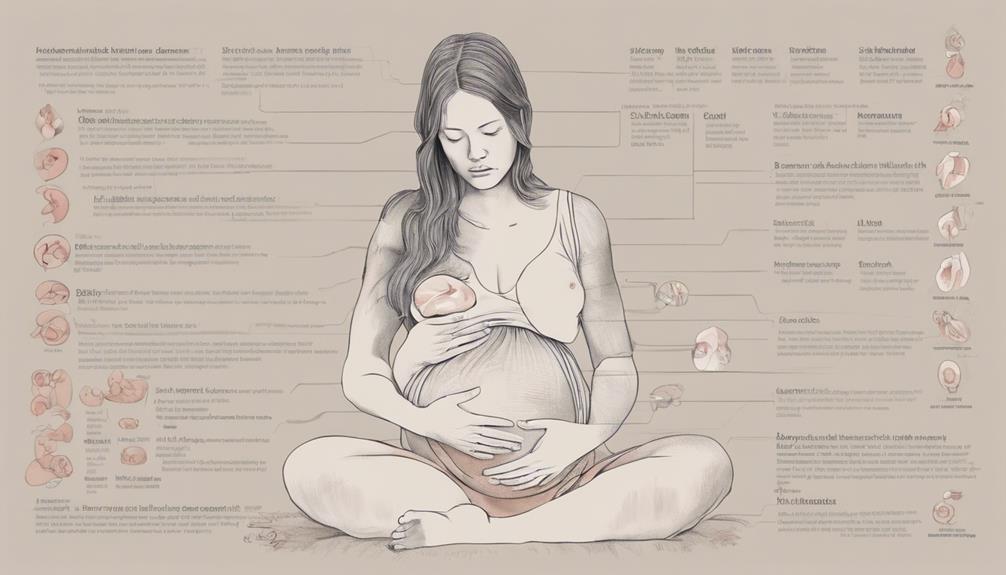It is crucial to acknowledge that approximately 10% of pregnant individuals experience a decrease in fetal movements during the final trimester. Feeling the movements of our babies is essential for forming a connection with our unborn child and monitoring their well-being. But what happens if there is a reduction in activity or the movements are not as strong?
Understanding the underlying causes of reduced fetal movement is paramount in ensuring a healthy pregnancy. Let's explore the factors that can lead to decreased fetal activity and why timely intervention is critical for both the mother and baby's health.
Key Takeaways
- Fetal sleep cycles and limited space affect movement perception.
- Medical conditions like preeclampsia and gestational diabetes impact fetal activity.
- Maternal factors including stress and lifestyle choices influence fetal movements.
- Environmental influences such as smoking and toxins can decrease fetal activity.
Common Causes of Reduced Fetal Movement
In our examination of common causes of reduced fetal movement in the third trimester, we find that various factors contribute to this phenomenon. Fetal sleep cycles, limited space due to the baby's size, and changes in the baby's position all play significant roles in decreased fetal movements during this stage of pregnancy. Fetal sleep cycles regulate periods of activity and rest, leading to variations in movement patterns. As the baby grows, the available space for movement within the womb becomes constrained, affecting the intensity and frequency of fetal movements. Additionally, shifts in the baby's position can alter the perception of movement for expecting mothers.
While these factors primarily relate to the baby's development, maternal influences such as stress, dehydration, or low blood sugar can also impact fetal movements in the third trimester. Moreover, conditions like placental insufficiency and certain medical conditions like preeclampsia or gestational diabetes can lead to decreased fetal activity by affecting the baby's oxygen and nutrient supply. Understanding these common causes can help expectant parents monitor fetal movements and seek timely medical advice when necessary.
Maternal Factors Impacting Fetal Activity

Factors affecting fetal activity in the third trimester include maternal influences like obesity, smoking, and diabetes. These maternal factors can have a significant impact on the intensity and frequency of fetal movements during this important stage of pregnancy. Additionally, stress, anxiety, maternal age, placental abnormalities, and gestational hypertension are other key factors that can influence fetal movements.
- Maternal stress and anxiety levels
- Presence of placental abnormalities
- Gestational hypertension
- Inadequate nutrition or dehydration
It is essential for expectant mothers to be aware of how these maternal factors can affect their baby's movements and overall well-being. Monitoring fetal movements regularly and seeking medical advice if there are any concerns is crucial. Proper management of maternal conditions and maintaining a healthy lifestyle can help promote ideal fetal activity levels in the third trimester, ensuring the best possible outcome for both the mother and the baby.
Potential Medical Conditions Affecting Fetal Movements
Maternal influences such as obesity, smoking, and diabetes can impact fetal movements in the third trimester, while potential medical conditions like gestational diabetes, preeclampsia, and placental insufficiency also play a role in affecting fetal activity. In addition to these conditions, intrauterine growth restriction (IUGR), fetal anomalies, and decreased amniotic fluid levels can contribute to decreased fetal movements. IUGR, characterized by inadequate growth of the fetus, is associated with reduced fetal activity. Fetal anomalies, including genetic conditions like chromosomal abnormalities, may also lead to decreased movements in the third trimester. Additionally, low amniotic fluid levels, known as oligohydramnios, can impact the baby's ability to move within the uterus.
| Medical Conditions | Impact on Fetal Movements |
|---|---|
| Gestational Diabetes | May lead to decreased movements |
| Preeclampsia | Can affect fetal activity |
| Placental Insufficiency | Linked to reduced fetal movements |
Lifestyle and Environmental Influences on Fetal Movement

Exposure to various lifestyle choices and environmental factors can greatly influence the level of fetal movement during pregnancy. When considering fetal movement, several key influencers stand out during the third trimester:
- Maternal smoking: Smoking has been connected to decreased fetal movement, impacting the baby's activity levels in the womb.
- Caffeine intake: Higher consumption of caffeine by the mother may lead to reduced fetal movements due to the substance crossing the placenta and affecting fetal behavior.
- Maternal stress: Elevated stress levels in the mother can result in decreased fetal activity, underscoring the importance of managing stress during pregnancy.
- Environmental toxins: Exposure to pollutants and chemicals can also contribute to decreased fetal movements, potentially affecting the baby's activity levels.
It is important for expectant mothers to be mindful of these lifestyle influences on fetal movement to promote optimal health for both themselves and their babies during this critical stage of pregnancy.
When to Seek Medical Attention for Decreased Movements
In cases of decreased fetal movements, prompt medical attention is essential for ensuring the well-being of both the baby and the mother. If you notice a significant decrease in your baby's movements, especially in the third trimester, contacting your healthcare provider immediately is critical. Monitoring fetal movements is necessary, and seeking medical attention is recommended if you feel fewer than 10 movements in a 2-hour period. This prompt evaluation is necessary as decreased fetal movements can be a signal of potential issues such as fetal distress or placental problems. Any change in your baby's normal movement pattern should be promptly reported to your healthcare provider to guarantee both the baby's and the mother's health. Here is a table summarizing key points:
| Key Points | Details |
|---|---|
| Decreased Movements Threshold | Less than 10 movements in a 2-hour period |
| Potential Issues | Fetal distress, placental problems |
| Importance of Monitoring | Essential for the well-being of both the baby and the mother |
| Action Steps | Prompt evaluation and contacting healthcare provider in case of decreased fetal movements |
Frequently Asked Questions
How Can Stress and Anxiety During Pregnancy Affect Fetal Movement in the Third Trimester?
When we experience stress and anxiety during pregnancy, it can impact fetal movement in the third trimester. These emotions may lead to changes in hormone levels or blood flow, affecting the baby's activity levels. It's important to manage stress for peak fetal health.
Are There Any Natural Remedies or Techniques That Can Help Increase Fetal Movement in the Third Trimester?
We've found that gentle movements, like walking or changing positions, often encourage increased fetal activity in the third trimester. Hydration and consuming a small snack can also stimulate movement. Remember, consulting a healthcare provider is vital.
Can Certain Medications or Supplements Impact Fetal Movement in the Third Trimester?
Certain medications or supplements can impact fetal movement in the third trimester. We must consult healthcare providers before taking any new medications or supplements during pregnancy to guarantee the safety and well-being of our baby.
What Role Does the Baby's Position in the Womb Play in Decreased Fetal Movement in the Third Trimester?
In the third trimester, the baby's position in the womb can impact decreased fetal movement. A baby's position, such as being head down or breech, may affect how easily movements are felt by the mother.
Are There Any Specific Dietary Factors That Can Influence Fetal Movement in the Third Trimester?
When considering dietary factors influencing fetal movement in the third trimester, we find that certain nutrients like omega-3 fatty acids, found in fish, may promote fetal activity. Maintaining a balanced diet is important for ideal fetal development.
Conclusion
To sum up, understanding the causes of decreased fetal movement in the third trimester is essential for ensuring the well-being of both mother and baby. By tracking movement patterns and seeking prompt medical attention when needed, potential issues can be addressed promptly.
For example, Sarah noticed a significant decrease in her baby's movements and contacted her healthcare provider immediately. Through monitoring and intervention, it was discovered that her baby's position had changed, leading to the reduction in movement.









